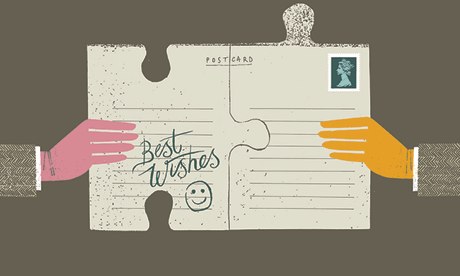
A friend of mine I'll call Nick (since that's his name) sporadically sends me postcards from his travels around the globe, on which the entire message, scrawled in large ballpoint letters, is "Best wishes, Nick." One interpretation of this is that Nick's a lazy bastard. Another is that he doesn't value our friendship sufficiently to spend five minutes telling me his news. But knowing how often I think about an absent friend, yet take no action to make contact, I'm inclined to conclude that his tactic's ingenious. The crucial thing about a postcard from afar, after all, is the fact of it, not some anecdote about haggling over souvenirs in a bazaar. By studiously ignoring the convention that postcards should contain news, he ensures they actually get sent. The difference between a detailed message and "Best wishes" is far smaller than between a postcard and no postcard at all.
But postcards are vanishing into history. Our post-postcard technologies – email, texts, cheap international calls, FaceTime, Skype – make it simple to stay in touch with distant friends. Or at least they're meant to. In practice, while Facebook and Twitter facilitate a feeling of connectedness to one's social circle in general, it's less easy to nurture specific bonds. There's something about sending an email or making a video call that seems to require having something substantive to say, especially if you've fallen out of touch. "Hello!" is insufficient, and a one-line message asking what someone's been up to feels unfair, since it implicitly demands a longer reply. No, we tell ourselves, catching up with friends is a matter of long, meandering chats, newsy emails, well-chosen gifts. And so the crucial work of nurturing friendships falls into a familiar procrastinatory black hole: precisely because it matters, you postpone it until you can give it the attention it deserves, which often means never.
So I was intrigued by an embryonic project by the London-based designer Kwame Ferreira – currently in prototype, and seeking backers at the crowdfunding site Indiegogo – for a hi-tech bracelet called Bond. Bonds comes in pairs; you keep one and give the other to a friend. When one wearer taps his or her bracelet, the other vibrates, wherever it happens to be. (They're wirelessly linked to the wearers' smartphones.) To be sure, Bond seems more fitting for romantic partners: it's amusing to imagine Nick's expression of horror were I to suggest that we wore them. But surely the underlying idea – of wordless contact, to signify that someone has registered in your thoughts – could be implemented in other ways, for all kinds and levels of friendship? Maybe Facebook's "poke" feature is a start. I just wish it wasn't called "poke".
Meanwhile, the best piece of advice for maintaining long-distance connections is probably this: raise your standards when it comes to frequency of contact, but lower them when it comes to what that contact contains. Studies of social networks have shown that reciprocity – returning calls and emails – is one of the best predictors of lasting links: if you fail to get in touch because you've nothing worth saying, or too little time to say much of it, you'll be doing nobody any favours. Although it's rarely true where friendship's concerned: in this case, quantity trumps quality.
oliver.burkeman@theguardian.com

